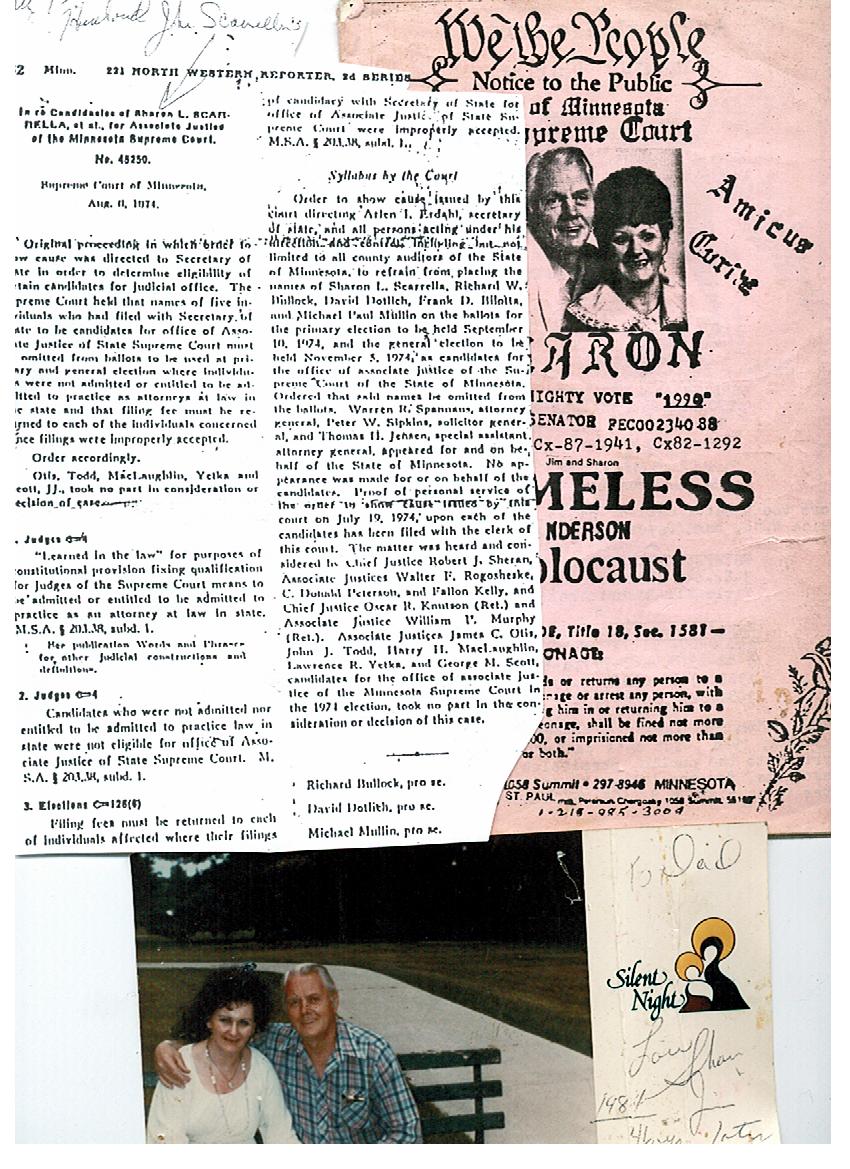Anderson, Sharon
| ||||||||||||||||||||||||||||||||||||||||||||||||||||||||||||||||||||||||||||||||||||||||||||||||||||||||||||||||||||||||||||||||||||||||||||||||||||||||||||||||||||||||||||||||||||||||||||||||||||||||||||
Saturday, December 5, 2009
Sharon Anderson Presidential Bid 1992
Sunday, August 9, 2009
Saturday, July 4, 2009
Wednesday, July 1, 2009
Saturday, June 27, 2009
Saturday, May 2, 2009
Judges Defining and Destroying Freedoms_CourtWatch
| |||||||||||||
|
| |||||||||||||
Sunday, March 8, 2009
Sunday, March 1, 2009
Abolish SCAP Secret Court_Judge Kathleen Gearin_Let the Truth be Known
 Lori Swanson MN-AG http://www.ag.state.mn.us/
Lori Swanson MN-AG http://www.ag.state.mn.us/
YouTube - BPBS
February 27, 2009
In this essay, Bill Moyers reflects on the passing of human rights activist Alison De Forge and writer and poet Christopher Nolan. Bill Moyers Journal airs Fridays at 9 p.m. on PBS (check local listings). For more: http://www.pbs.org/billmoyers
LET THE TRUTH BE KNOWN :


Kathleen Gearin Canvass Board-SCAP
political ?(Sharon4Anderson?)
Alliance for a Better Minnesota Sharon Anderson's Blog Click here: Sharon4Council file4[1]Shar_thune_22.pdf - Google Docs
Disclaimer on Site'sThe Electronic Communications Privacy Act MY FindLaw (ECPA) sets out the provisions for access, use, disclosure, interception and privacy protections of electronic communications. Sharon4Anderson Scribd pdf files. The law was enacted in 1986 and covers various forms of wire and electronic communications. According to the U.S. Code, electronic communications "means any transfer of signs, signals, writing, images, sounds, data, or intelligence of any nature transmitted in whole or in part by a wire, radio, electromagnetic, photo electronic or photo optical system that affects interstate or foreign commerce." ECPA prohibits unlawful access and certain disclosures of communication contents. Additionally, the law prevents government entities from requiring disclosure of electronic communications from a provider without proper procedure. The Legal Institute provides Title 18 of the U.S. Code, which encompasses ECPA. Blogger: Dashboard AndersonAdvocates/ddaweborg.msnw
NOTICE: This communication is not encrypted. This e-mail (including any attachments) is covered by the Electronic Communications Privacy Act, 18 U.S.C. §§ 2510-2521, and Electronic Communications Privacy Act The CAN-SPAM Act: Requirements for Commercial Emailers
| Subject: | Abolish MN SCAP Court |
| Date: | 3/1/2009 3:10:27 P.M. Central Standard Time |
| From: | |
Wednesday, February 25, 2009
MN Courts_Antiquated_No Confidence
Courts warn of service cuts
ST. PAUL — Minnesota’s court officials say Minnesotans will see significant service cuts if Gov. Tim Pawlenty’s proposed budget passes, but the governor says the court budget needs trimming as a way to pressure them to change.By: By Don Davis and Kelly Boldan, West Central Tribune
(click play to listen)
ST. PAUL — Minnesota’s court officials say Minnesotans will see significant service cuts if Gov. Tim Pawlenty’s proposed budget passes, but the governor says the court budget needs trimming as a way to pressure them to change.
“The court is antiquated and needs significant reform,” Pawlenty said Tuesday. “The courts need to change and improve their processes. All the paperwork needs to become electronic in nature.”
The governor’s comments, made to the West Central Tribune in Willmar, mirrored long-term plans court officials outlined Tuesday to the House Public Safety Committee. But court officials were talking about changes further down the road than Pawlenty apparently wants.
Pawlenty and many legislators say cuts are needed to deal with a state budget deficit, while court officials say they need to be saved from those cuts and get $5.6 million more to begin making technological changes to streamline the court system.
Judge John Rodenberg, who works in south-central Minnesota, said the court system now is mostly paper-based. He and other judicial officials asked the House Public Safety Committee to back their proposal for funds to use technology to improve the courts.
Any increase in funding appears doubtful for the courts, even with promises of long-term improvements.
Rep. Dave Olin, DFL-Thief River Falls, said all parts of the state budget will be cut in light of what many predict will be a $7 billion deficit in a $33 billion budget.
“It is not an easy decision because everyone has to be in this together ... ” Olin said. “There are going to be some cuts that are not very popular. That is just a fact of life.”
Chief Justice Eric Magnuson has traveled the state warning Minnesotans that the 5 percent cut Pawlenty proposes would mean courts would drop 21 types of cases because they just would not have enough time to deal with them.
“All of these cases are important to those who bring them,” Judge James T. Swenson of Hennepin County said.
If the Pawlenty plan prevails, court leaders expect to lose 405 jobs — 15.5 percent of their work force — and stop hearing cases ranging from truancy to shoplifting, consumer credit to traffic.
The cuts could delay cases so long that some home buyers would not be able to close purchases, Swenson said, when they need judges to clean up deeds.
“We cannot do all the work that comes into our door,” said state Court Administrator Sue Dosal. “There will be no consequences for shoplifting ... worthless checks, things like that.”
Pawlenty said that he sticks with his plan to make cuts because the courts have not changed quickly enough.
“Yes, we can find a middle ground for the state justice system,” the Republican governor said during his Willmar stop. “We just need to have better accountability and reform the system to make it more efficient.”
For instance, he said, 90 percent of drunken driving violations have standard outcomes. “Could they be handled more efficiently; rather then tying up court time?”
Also, he said, the courts need to find new ways to deal with the high volume of cases “and other inefficiencies.”
“We need to keep the pressure on to facilitate the reform,” the governor said.
Olin, a longtime Pennington County attorney, said that he thinks the court is right in saying that Pawlenty’s cuts will be felt by Minnesotans.
“Having worked in the court system for years, it is getting to be that bad,” he said. “The courts are getting more and more cases and it is getting worse yearly.”

